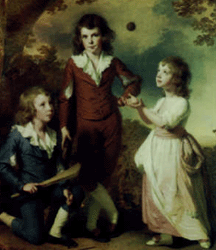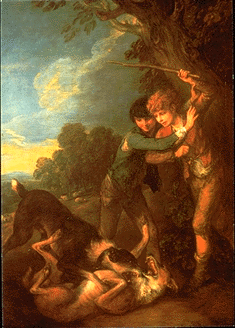Class
Consciousness
One of the most significant didactic
purposes of children's literature was to reinforce the social
structure of the time period and particular, reinforcing class
boundaries. This manifested itself in numerous ways.
 Both the primary
audience and authors of children's literature were from the upper
classes of society, and the books reflect it. Only wealthy children
from the aristocracy or middle classes had money to purchase books (a
book might have cost a sixpence), so the reading catered to that
group of people. The numbers of upper class characters was large and
disproportionate compared to the number of poor characters, and in
general the upper class was portrayed in a positive light. And while
wealthy characters had all sorts of personalities, in general their
good points were emphasized.33 The painting on the left, "The Wood Children" by
Joseph Wright, depicts such well behaved wealthy children.
Both the primary
audience and authors of children's literature were from the upper
classes of society, and the books reflect it. Only wealthy children
from the aristocracy or middle classes had money to purchase books (a
book might have cost a sixpence), so the reading catered to that
group of people. The numbers of upper class characters was large and
disproportionate compared to the number of poor characters, and in
general the upper class was portrayed in a positive light. And while
wealthy characters had all sorts of personalities, in general their
good points were emphasized.33 The painting on the left, "The Wood Children" by
Joseph Wright, depicts such well behaved wealthy children.
 This
is not to say that poor characters made no appearances. When they
did, however, they were often recipients of the charity of wealthy
characters. Mary Ann Kilner, in her story Memoirs of A Peg-Top, tells of the rich Mr. Jackson who assists a poor
old woman who has been the victim of vandalism by some boys. In
The Life and Perambulation of A
Mouse, a tale by Dorothy Kilner, a
wealthy boy brings a poor little girl a piece of cake. Stories such
as these encouraged the wealthy to take pity on hard-working poor
people, who were supposed to be content with their lot. Lazy or
begging members of the working class, however, were painted in a very
negative light. Such a portrayal might have looked something like
"Two Shepherd Boys with Dogs Fighting", by Thomas
Gainsborough.
This
is not to say that poor characters made no appearances. When they
did, however, they were often recipients of the charity of wealthy
characters. Mary Ann Kilner, in her story Memoirs of A Peg-Top, tells of the rich Mr. Jackson who assists a poor
old woman who has been the victim of vandalism by some boys. In
The Life and Perambulation of A
Mouse, a tale by Dorothy Kilner, a
wealthy boy brings a poor little girl a piece of cake. Stories such
as these encouraged the wealthy to take pity on hard-working poor
people, who were supposed to be content with their lot. Lazy or
begging members of the working class, however, were painted in a very
negative light. Such a portrayal might have looked something like
"Two Shepherd Boys with Dogs Fighting", by Thomas
Gainsborough.
In addition, many characters in such
literature commented on the class structure and concluded that it was
a good one. In The Canary
Bird, by Alicia Catharine Mant, the
canary remarks that he has heard a "sensible looking man" say that
the distinctions between the classes "must be kept up.... If mankind
do not wish to see a chaotic confusion in society." Other wealthy
characters vehemently oppose any connection to the lower classes.
Mrs. Fry, an upper class mother of the story The Adventures of a Doll, is offended by two lower class girls because they
have the same name as her wealthy daughter.
32
 Both the primary
audience and authors of children's literature were from the upper
classes of society, and the books reflect it. Only wealthy children
from the aristocracy or middle classes had money to purchase books (a
book might have cost a sixpence), so the reading catered to that
group of people. The numbers of upper class characters was large and
disproportionate compared to the number of poor characters, and in
general the upper class was portrayed in a positive light. And while
wealthy characters had all sorts of personalities, in general their
good points were emphasized.33 The painting on the left, "The Wood Children" by
Joseph Wright, depicts such well behaved wealthy children.
Both the primary
audience and authors of children's literature were from the upper
classes of society, and the books reflect it. Only wealthy children
from the aristocracy or middle classes had money to purchase books (a
book might have cost a sixpence), so the reading catered to that
group of people. The numbers of upper class characters was large and
disproportionate compared to the number of poor characters, and in
general the upper class was portrayed in a positive light. And while
wealthy characters had all sorts of personalities, in general their
good points were emphasized.33 The painting on the left, "The Wood Children" by
Joseph Wright, depicts such well behaved wealthy children.
 This
is not to say that poor characters made no appearances. When they
did, however, they were often recipients of the charity of wealthy
characters. Mary Ann Kilner, in her story Memoirs of A Peg-Top, tells of the rich Mr. Jackson who assists a poor
old woman who has been the victim of vandalism by some boys. In
The Life and Perambulation of A
Mouse, a tale by Dorothy Kilner, a
wealthy boy brings a poor little girl a piece of cake. Stories such
as these encouraged the wealthy to take pity on hard-working poor
people, who were supposed to be content with their lot. Lazy or
begging members of the working class, however, were painted in a very
negative light. Such a portrayal might have looked something like
"Two Shepherd Boys with Dogs Fighting", by Thomas
Gainsborough.
This
is not to say that poor characters made no appearances. When they
did, however, they were often recipients of the charity of wealthy
characters. Mary Ann Kilner, in her story Memoirs of A Peg-Top, tells of the rich Mr. Jackson who assists a poor
old woman who has been the victim of vandalism by some boys. In
The Life and Perambulation of A
Mouse, a tale by Dorothy Kilner, a
wealthy boy brings a poor little girl a piece of cake. Stories such
as these encouraged the wealthy to take pity on hard-working poor
people, who were supposed to be content with their lot. Lazy or
begging members of the working class, however, were painted in a very
negative light. Such a portrayal might have looked something like
"Two Shepherd Boys with Dogs Fighting", by Thomas
Gainsborough.